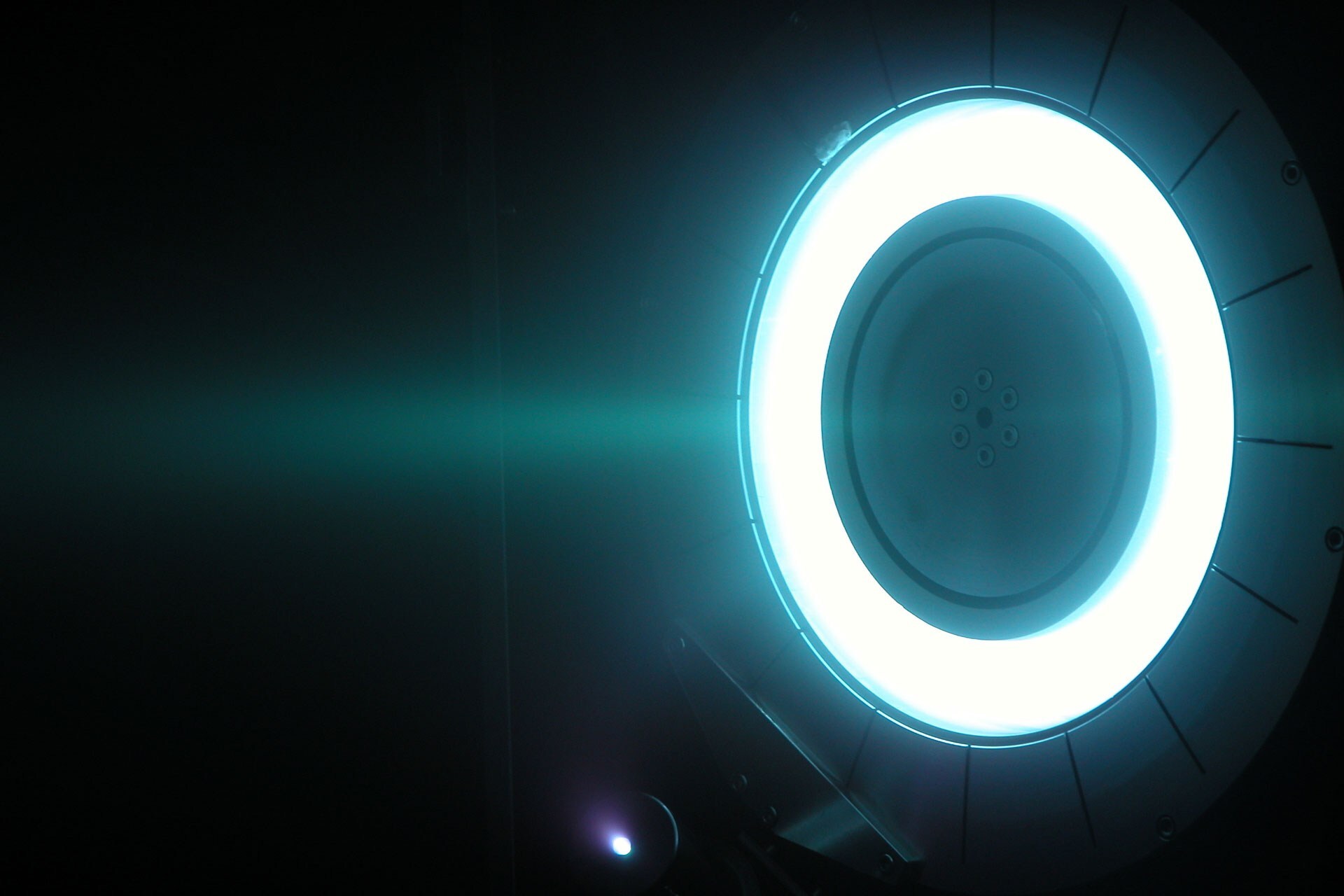satellite powered entirely by ion engines

Getting a satellite into orbit is only the first step in making it a useful piece of equipment. It also needs to arrive in the correct orbit and stay there, known as station-keeping. In the past this was accomplished with chemical propulsion, but more modern satellites have relied upon a mix of chemical and electric propulsion. Now Boeing has announced the first all-electric ion propulsion satellite is fully operational.
The satellite in question doesn’t have a snappy name — it’s a communications satellite called ABS-3A 702SP. It was launched last March aboard a SpaceX Falcon 9 rocket. It has just recently been handed over to its owner, Bermuda-based telecommunications company ABS. Because ABS-3A is a communications satellite, it needs to remain in a geosynchronous orbit. Thus, station-keeping is essential. When it can no longer maintain its orbit, it will cease being useful. Ion thrusters make a lot of sense in this scenario.
Ion engines operate on the same basic principles of physics that chemical thrusters do — expel mass from a nozzle to push a craft in the opposite direction. Instead of the combustion of volatile chemicals, ion engines operate with chemically inert xenon gas. Using an electrostatic field, the ionized gas is accelerated out of the nozzle, propelling the craft forward. This is the same type of thruster technology used on NASA’s Dawn spacecraft, which is currently studying the dwarf planet Ceres.
Ion thrusters are considerably more efficient than conventional rocket motors. In this case, Boeing claims the Xenon Ion Propulsion System (XIPS) designs used for ABS-3A is ten times more efficient than liquid fueled rockets. ABS-3A needs only 11 pounds (5kg) of xenon gas per year to maintain station-keeping, meaning it can remain operational much longer than a similar satellite with conventional thrusters. ABS expects the satellite to remain active for about 15 years. Ion thrusters are also considerably lighter than chemical engines, making launches cheaper. The drawback is the very low thrust of an ion engine. That’s why past satellites have carried conventional thrusters as well.
Upon delivery to orbit, ABS-3A used its ion thrusters to reach a geosynchronous orbit at 3 degrees west longitude. After being tested by Boeing, the satellite was turned over to ABS on August 31st. Now that the design has proven itself viable, Boeing is forging ahead with a second satellite for ABS using the same XIPS engines. This one will be blasted into space sometime next year.
The first satellite powered entirely by ion engines is online | ExtremeTech

Getting a satellite into orbit is only the first step in making it a useful piece of equipment. It also needs to arrive in the correct orbit and stay there, known as station-keeping. In the past this was accomplished with chemical propulsion, but more modern satellites have relied upon a mix of chemical and electric propulsion. Now Boeing has announced the first all-electric ion propulsion satellite is fully operational.
The satellite in question doesn’t have a snappy name — it’s a communications satellite called ABS-3A 702SP. It was launched last March aboard a SpaceX Falcon 9 rocket. It has just recently been handed over to its owner, Bermuda-based telecommunications company ABS. Because ABS-3A is a communications satellite, it needs to remain in a geosynchronous orbit. Thus, station-keeping is essential. When it can no longer maintain its orbit, it will cease being useful. Ion thrusters make a lot of sense in this scenario.
Ion engines operate on the same basic principles of physics that chemical thrusters do — expel mass from a nozzle to push a craft in the opposite direction. Instead of the combustion of volatile chemicals, ion engines operate with chemically inert xenon gas. Using an electrostatic field, the ionized gas is accelerated out of the nozzle, propelling the craft forward. This is the same type of thruster technology used on NASA’s Dawn spacecraft, which is currently studying the dwarf planet Ceres.
Ion thrusters are considerably more efficient than conventional rocket motors. In this case, Boeing claims the Xenon Ion Propulsion System (XIPS) designs used for ABS-3A is ten times more efficient than liquid fueled rockets. ABS-3A needs only 11 pounds (5kg) of xenon gas per year to maintain station-keeping, meaning it can remain operational much longer than a similar satellite with conventional thrusters. ABS expects the satellite to remain active for about 15 years. Ion thrusters are also considerably lighter than chemical engines, making launches cheaper. The drawback is the very low thrust of an ion engine. That’s why past satellites have carried conventional thrusters as well.
Upon delivery to orbit, ABS-3A used its ion thrusters to reach a geosynchronous orbit at 3 degrees west longitude. After being tested by Boeing, the satellite was turned over to ABS on August 31st. Now that the design has proven itself viable, Boeing is forging ahead with a second satellite for ABS using the same XIPS engines. This one will be blasted into space sometime next year.
The first satellite powered entirely by ion engines is online | ExtremeTech
